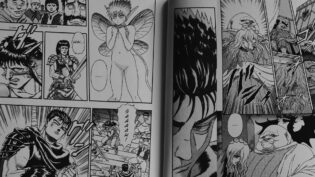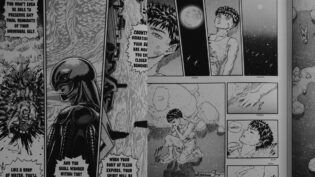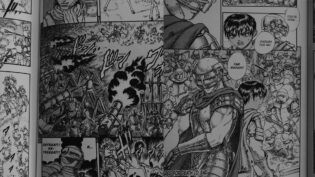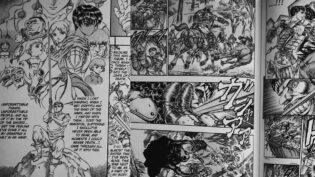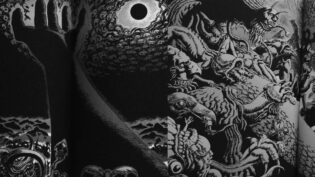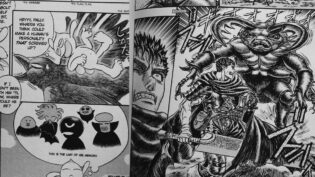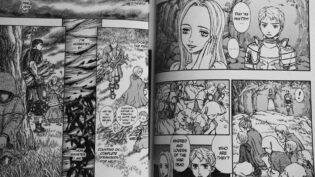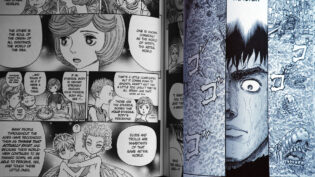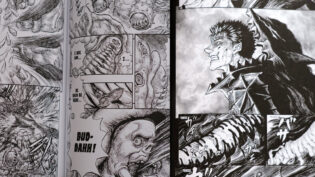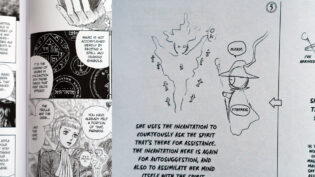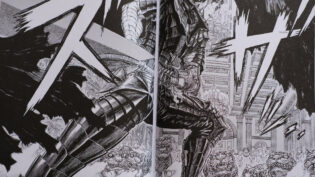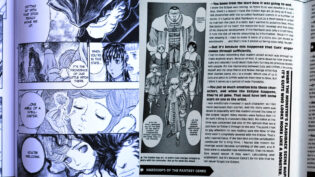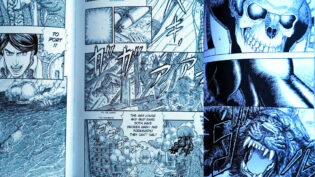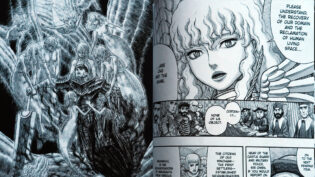Berserk became the first manga I’ve read. I rarely watch anime either, so when a good friend of mine, who has great taste in good storytelling, suggested I watch the 90s anime adaptation of Berserk around 2004 or so, I went in with no expectations. Yet I loved it and immediately went for the source material, just as said friend already did, downloading and reading through all of the scans of the fan translated manga that, at that point, has just started to get officially translated and sold in the US, which was way too expensive to import to Ukraine. Decades went by and amidst the ongoing russian full scale invasion of Ukraine I decided to gift myself the full set of currently released hardcover Deluxe volumes from Dark Horse, importing them through Amazon and re-experiencing Berserk from the beginning in the way I never could before.
Kentaro Miura, the author of the manga, unfortunately passed away in 2021 and the episodes released since that time were done under the supervision of his friend and colleague Kouji Mori, who is trying to finish the story. He is, however, only doing what Miura described to him, without any additional embellishments and episodes of his own, so as a result, the storytelling is a lot more condensed and already starting to resemble the shorter more unfinished elements of The Silmarillion. I’m still hoping to see the end of the Berserk story as Kentaro Miura has envisioned it, but it clearly won’t be told in the way he would’ve wanted if he could. In this post I wanted to share some of my thoughts and love about Kentaro Miura’s Berserk in its completed, and sadly unfinished, form. And maybe revisit this topic again once the story concludes with the help of other people.
Berserk has often been described as extremely violent, gory, dark and having lots of cool action scenes. Which isn’t exactly untrue, but it’s not the reason why the manga remained popular for all these years instead of blending with numerous other cool manly shōnen or seinen manga series. When you start reading Berserk and go through its initial chapters focusing on the “Black Swordsman” Guts is walking around the world with a strange brand that attracts demon-like entities, which he’s fine with because he’s waging a war on them and intentionally creating situations to lure them out. You get sex, violence, gore and different horrible scenes right from the start and, frankly, it feels very “edgy”. You can feel some interesting nuance to the storytelling and the drawing style, especially in the second big chapter of the opening arc that feels almost like a restart of the manga, but at the same time, the story is dead simple. And judging by what Miura said himself, at that point he just wanted to create a story about a cool looking dude who wants revenge on demons with the main gimmick being that it had to fit into some aspects of realism and real medieval history. Yet, this is not when the manga got really popular.
The second huge arc of the manga is the actual chronological beginning of the story that shows what made Guts the way he is and what are the reasons behind the revenge. And its here when things start to come together nicely. Kentaro Miura turned out to be the kind of storyteller, that lets the story and its characters grow, even if it means adapting to what the story needs, rather than forcing it to go the way you originally intended. As a result, a lot more focus from that point on goes into the character and world building and slower scenes. That are always very nicely balanced out by amazing action sequences and huge epic battle scenes. Research of real history and other fictional worlds serves as a strong backbone of the world and story that Miura creates, enhancing the overall experience. With the episodes flowing one into another with not a single pacing issue in sight.
Not that the whole horror theme and the violence goes away, it’s still central to the very dark story of the manga. But the farther you go, the less exploitative it becomes. The opening chapters often go for easier and “cheaper” tropes and sexual violence is thrown around like its nothing. It’s always creepy and has gravity to it, as it should, but often feels added just to get a cheap emotional response from the readers. But it’s one of many details that matures with the author and you get less and less cliches and tropes just for the sake of them as the manga develops. It’s really impressive to see Miura grow as an artist as well. While even the prototype version of Berserk, that is included in the collected editions, looked quite good, by the time you get to the latest volumes you get incredible scenes that show the action and emotions through incredibly detailed and beautiful pictures and start relying on words less and less.
Speaking of the unfinished status of the manga – I’m almost sure that if Kentaro Miura could have it his way, once he would’ve finished the story, he would’ve wanted to “remaster” the entire manga. Go back to the beginning and adjust things, structure the volumes by arcs… That’s one thing that’s somewhat frustrating about all of the existing releases, including the Deluxe hardcover – they’re not collected in a structured story manner. The manga is divided into several Arcs, each of those are vaguely divided into chapters which in turn are divided into “episodes”. Each episode was released one by one in the Monthly Animal House (at the very beginning) and then Young Animal magazines. And then, as it usually happens with manga in general, a collection of such episodes would be collected and released in a tankōbon volume. The hardcover Deluxe edition collects several of these volumes into one huge volume. But you can have one Arc end somewhere in the middle of a tankōbon with no regard to structured storytelling, because that’s how the manga publishing works, apparently.
As for the official localization, while it’s very good and the print is fantastic in general, it is a bit of a shame that even with the Deluxe edition re-releases Dark Horse didn’t go back to update the elements of translation that has been a sore spot for years. Like the fact that the Griffith is called Hawk in their official translation, despite Miura’s constant explicit attempts to show that he always wanted him to be called Falcon instead. Leading to some hilariously silly situations in later episodes, where a city created in the name of “The Hawk” is called “Falconia”. Other than that, it’s just worth noting that the “Berserk Official Guidebook” that has also been published by Dark Horse and included in the latest Deluxe volume is… questionable? It’s an odd thing that has some contradictory information and seems gimmicky, with the only really cool aspect of it being the interview with the author from 2016 and a collection of reference sketches he made for characters. But otherwise, I’d definitely recommend getting the translated editions and if you can afford it (and have space, as they’re huge and heavy) the Deluxe editions are incredible.
Either way, I recommend reading Berserk if you have a chance. It’s an incredible piece of storytelling and a really exciting and thrilling adventure. If you’ve played any of the From Software’s Souls games you probably already know that, given how much influence did the manga had on them. But if you’re not, or if you’ve thought that the whole draw of Berserk is violence and horror – no, it’s there but people stay for the characters and storytelling, not death and boobs. As for the adaptations? The 90s anime was quite good and if you want to quickly check what Berserk is about, it could be a good starting point as it was for me. As for the later adaptations – I’ve not seen them, because that good friend of mine with good taste in storytelling said that they sucked. So… probably not worth it. And if you’ve been someone who, like me, followed the story episode by episode for many years – read the whole thing from the beginning. You’ll get new appreciation for how well told this story is.


